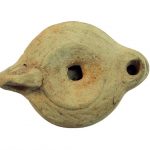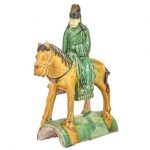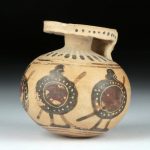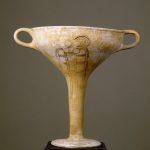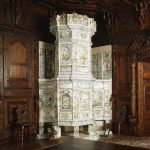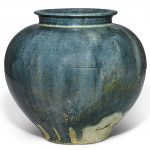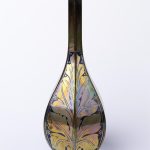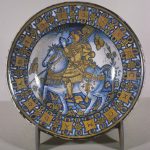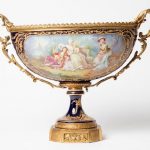An Iznik pottery dish Turkey, circa 1600 Decorated in raised red, blue, green and black, with a saz leaf, tulips, a rose, a carnation and other flowers issuing from a leafy tuft. 25.7cm diameter
Sold for £ 750 inc. premium at Bonhams in 2018
Romano British pottery lamp AD 43 to circa AD 410.
Reference: © The Trustees of the British Museum
A SANCAI-GLAZED POTTERY CAMEL TANG DYNASTY (618-907) The Bactrian camel is modelled standing foursquare on a rectangular base with its head is held high and its mouth open. An oval blanket with a pleated border is draped over its humps. The saddle-cloth and the throat are covered in a cream glaze, and the body and legs in an amber glaze, all highlighted with splashes of green, amber and cream glazes. 22 ½ in. (57 cm.) high
Sold for GBP 11,875 at Christies in 2018
Chinese Sancai Glazed Pottery Roof Tile Ming Dynasty Style Height 12 inches chips to tips of horses ears and to plume on trapping over the nose, area of glaze wear on horses tail; other shallow flake losses to glaze; flake chip loss located along bottom outer rim edge; not blacklighted
Sold for $281 (includes buyer’s premium) at Doyle New York in 2018
Greek Pottery Aryballos w/ Hoplites
Ancient Greece, Corinthia, Archaic period, ca. 6th century BCE. A squat pottery aryballos (used for holding scented oils and perfumes) of a classic globular form with a flat, circular rim and a single strap handle. Painted around the body is a profusion of hoplites, their bodies posed with spears and shields at the ready. The neck displays a radiating linear design around its circumference. A beautiful example! Size: 2″ W x 2.1″ H (5.1 cm x 5.3 cm)
Sold for $295 at Artemis Gallery in 2018
This vase, formerly described as a “champagne cup”, is a Myceanaean cup of the “Zygories” type. Its elongated form comprises a tall stem on a flat disc-shaped foot supporting a deep bowl with thin sides and two round handles. The near-abstract decoration combines a stylized representation of an octopus and a floral motif. Stylized representations of sea creatures are found on numerous vases, testifying to the infuence of Cretan artists on Mycenaean art.
Reference:The Louvre
This colorful, large, ceramic stove was made for the paneled room in which it still stands, the Reiche Stübe, or “Rich Room,” of the Schlössli (Little Castle), a manor house built in 1682 for Johann Gaudenz von Capol (1641–1723), a member of the leading family of Flims, in the Protestant canton of Grisons in eastern Switzerland. Stoves were common in alpine regions, where the bitter cold of winter was unrelieved for months at a time. They provided continuous radiant heat, facilitated by the white reflecting surface of the tiles. The enclosed fire both conserved wood fuel and removed the danger of smoke and sparks common with open fires.
Reference: The Metropolitan Museum of Art
A Pates Potteries model for a swordfish ornament.
Reference: Museum of Applied Art and Sciences
A SUPERB BLUE-GLAZED POTTERY JAR TANG DYNASTY covered in a mottled greenish-blue glaze with a silver sheen, the glaze stopping irregularly above the foot h. 20.8 cm, 8 1/4 in.
Sold for 81,250 HKD at Sothebys
Lancastrian pottery bottle with six sides and narrow neck. earthenware. Painted in gold lustre glaze with acanthus leaves on a blue glaze ground.
Reference: © Victoria and Albert Museum
This dish shows Constantine (272-337 CE), the first Christian Emperor of Rome, on horseback carrying a banner. He clasps his hands together in an attitude of prayer, and lifts his face to a series of waved rays, representing heavenly guidance, emanating from the top of the center roundel. The inscription, “Io mare chomado a Dio,” (I commend myself to God) is displayed on the outer ring. Constantine’s dramatic conversion and military victories made him the ideal Christian soldier, and his presence on a dish would have reminded the owner to follow his example. The back of the dish is painted with a greenish-yellow glaze and marked with a cross in the center.
Reference: The Walters Art Museum

